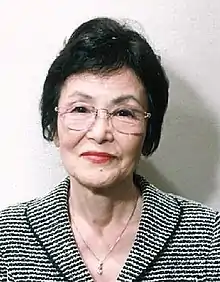Setsuko Tsumura
Setsuko Tsumura (津村節子, Tsumura Setsuko, born 5 June 1928) is a Japanese novelist. She is a 1965 recipient of the Akutagawa Prize.
Setsuko Tsumura | |
|---|---|
 | |
| Native name | 津村 節子 |
| Born | 5 June 1928 |
| Occupation | Writer |
| Nationality | Japanese |
| Notable works | "Gangu" (Toys) |
| Notable awards | Akutagawa Prize |
| Spouse | Akira Yoshimura |
Early life
Tsumura was born in the capital city of Fukui, Japan. Her mother died when she was nine years old. Two years later, she moved to Tokyo. Her father, a silk weaver, died when she was sixteen. Between 1947 and 1948, at the age of nineteen, Tsumura ran her own dressmaking shop, employing three other dressmakers. Despite the success of her business, she closed the shop to attend Gakushuuin Women's Junior College, where she studied literature and edited the student literary magazine.[1] She met her husband, Akira Yoshimura (1927–2006),[2] while contributing to the literary magazine at his college. Tsumura graduated in 1953 and married soon after.[1]
Career
Tsumura was nominated for the Naoki Prize in 1959 for her short story, "Kagi" (Key), which she wrote for Bungakukai magazine. She was awarded the Akutagawa Prize in 1965 for her short story "Gangu" (Playthings), a story about an expectant mother who is disappointed by her husband's indifference to their pregnancy. In 1972, Tsumura's short story, "Saihate" (The Farthest Limit) won the Shincho Prize. It was based on Tsumura's personal experience after the collapse of her husband's business.
Tsumura's 1983 biographical novel, Shirayuri no kishi (Precipice of a White Lily) is about Tomiko Yamakawa (1879–1909), a poet from Tsumura's native Fukui.
Tsumura's novel, Ryuuseiu (A Meteoric Shower) won the Women's Literature Prize in 1990. It depicted the Boshin War from the perspective of a 15-year-old girl.[1]
She is a member of the Japan Art Academy and was recognized as a person of cultural merit in 2016.[3]
Bibliography
Type of literary work denoted in parentheses.
| Japanese title | Reading | English title | Publish date | Publisher |
|---|---|---|---|---|
| 海鳴 (novel) | Umi nari | Rumbling of the Sea | 1965 | Kodansha |
| 風の吹く町 (short story collection) | Kaze no fuku machi | The Windy Town | 1970 | Gekkan-pensha |
| 白い焔 (short story collection) | Shiroi honoo | White Flames | 1971 | Yomiuri-shimbunsha |
| さい果て (short story collection) | Saihate | The Farthest Limit | 1972 | Chikumashobo |
| ?? (short story collection) | Tomurai me | Woman Undertaker | 1973 | Chikumashobo |
| 炎の舞い (novel) | Honoo no mae | Blazing Dance of the Kiln | 1975 | Shinchosha |
| 星がゆれる時 (novel) | Hoshi ga yureru toki | When the Star Trembles | 1976 | Kobunsha |
| 遅咲きの梅 (novel) | Osozaki no ume | Late-Blooming Plums | 1978 | Chuokoronsha |
| ?? (novel) | Haru no yokan | Spring Anticipation | 1979 | Bungeishunjusha |
| 重い歳月 (novel) | Omoi saigetsu | Heavy Months | 1980 | Shinchosha |
| 冬の虹 (novel) | Fuyu no niji | Winter Rainbow | 1981 | Shinchosha |
| 母の部屋 (short story collection) | Haha no heya | My Mother's Room | 1982 | Shueisha |
| 白百合の崖(biography) | Shirayuri no kishi | Precipice of a White Lily | 1983 | Shinchosha |
| 海の星座 (novel) | Umi no seiza | The Sea Constellation | 1984 | Mainichi-shimbunsha |
| 千輪の華 (novel) | Senrin no hana | Thousand Flowers | 1985 | Shinchosha |
| 土と炎の里(essays) | Tsuchi to honoo no sato | The Village of Clay and Blaze | 1986 | Chuokoronsha |
| 惑い (short story collection) | Madoi | Delusion | 1987 | Yomiuri-shimbunsha |
| 幸福村 (short story collection) | Koofuku na mura: Ten ro | The Village of Happiness: A Sculling Oar of Heaven | 1989 | Shinchosha |
| 霧棲む里 (novel) | Kiri sumu sato | A Foggy Village | 1989 | Kodansha |
| 流星雨 (novel) | Ryuuseiu | A Meteoric Shower | 1990 | Iwanamishoten |
| 紅梅 (novel) | Koobai | Red Blossomed Plum Tree[4] | 2011 | Bungeishunjusha |
Translated works
Tsumura's 1969 short story "Yakoodokei" (夜光時計) was translated under the title "Luminous Watch." It is included in the anthology This Kind of Woman: Ten Stories by Japanese Women Writers by Elizabeth Hanson and Yukiko Tanaka.[5][1]
"Gangu," the short story that won Tsumura the Akutagawa Prize, was translated by Kyoko Evanhoe and Robert N. Lawson for the Japan Quarterly in 1980 under the name "Playthings."[1]
References
- Schierbeck, Sachiko Shibata; Edelstein, Marlene R. (1994). Japanese Women Novelists in the 20th Century: 104 Biographies, 1900-1993. Museum Tusculanum Press. ISBN 9788772892689.
- "Mitaka City| Mitaka City honorary citizen (3)". www.city.mitaka.tokyo.jp.e.nf.hp.transer.com. Retrieved 2019-10-21.
- "平成28年度 文化功労者:文部科学省". www.mext.go.jp. Retrieved 2019-10-23.
- Britannica Book of the Year 2012. Encyclopaedia Britannica, Inc. 2012-03-01. ISBN 9781615356188.
- Mulhern, Chieko Irie (1994). Japanese Women Writers: A Bio-critical Sourcebook. Greenwood Publishing Group. ISBN 9780313254864.